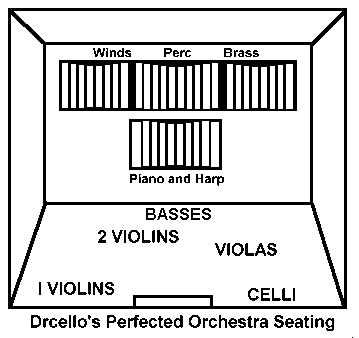
Conductors are wont to experiment with all sorts of incorrect orchestral seating arrangements. These failures are often self-evident to cellists, who are of a higher order of intelligence, and who have a good share of plain common sense. Others in the orchestra, especially the brass, just don't get it, and are often just as confused as the conductor.
In an altruistic effort to finally straighten things out, webmaster has devised the "Perfected Orchestral Seating Arrangement," which meets the needs of all instrumentalists and conductors, and which could usher in a new era of orchestral joy and harmony, if only we can get enough conductors to adopt it. webmaster is confident that the best orchestras will soon be using this arrangement, since it is obviously superior. Here is a diagram and an explanation. Please feel free to print this and distribute it widely.

The real innovation here is the placing of the winds, percussion, brass, piano and harp in built-in enclosures on the rear wall of the stage, elevated to a level at which they will not be blowing and pounding directly into the ears of those who sit in front of them. Their "sounds" will go over the heads of the strings, and out into the auditorium. Not only that, each enclosure has its own separately controlled set of louvers, adjustable by the conductor electronically from the podium. Thus he can easily tone down the sound produced by these "instruments" in the same fashion as an organist controls the volume of the various families of organ pipes.
The strings occupy the floor of the stage in the traditional seating which over hundreds of years of development has been recognized by all intelligent musicians to be the best arrangement. The celli are up close to the audience, because the audience is naturally more interested in watching and hearing them, thus keeping the audience happy and ensuring their return to the next concert.
Best wishes to all, "webmaster."